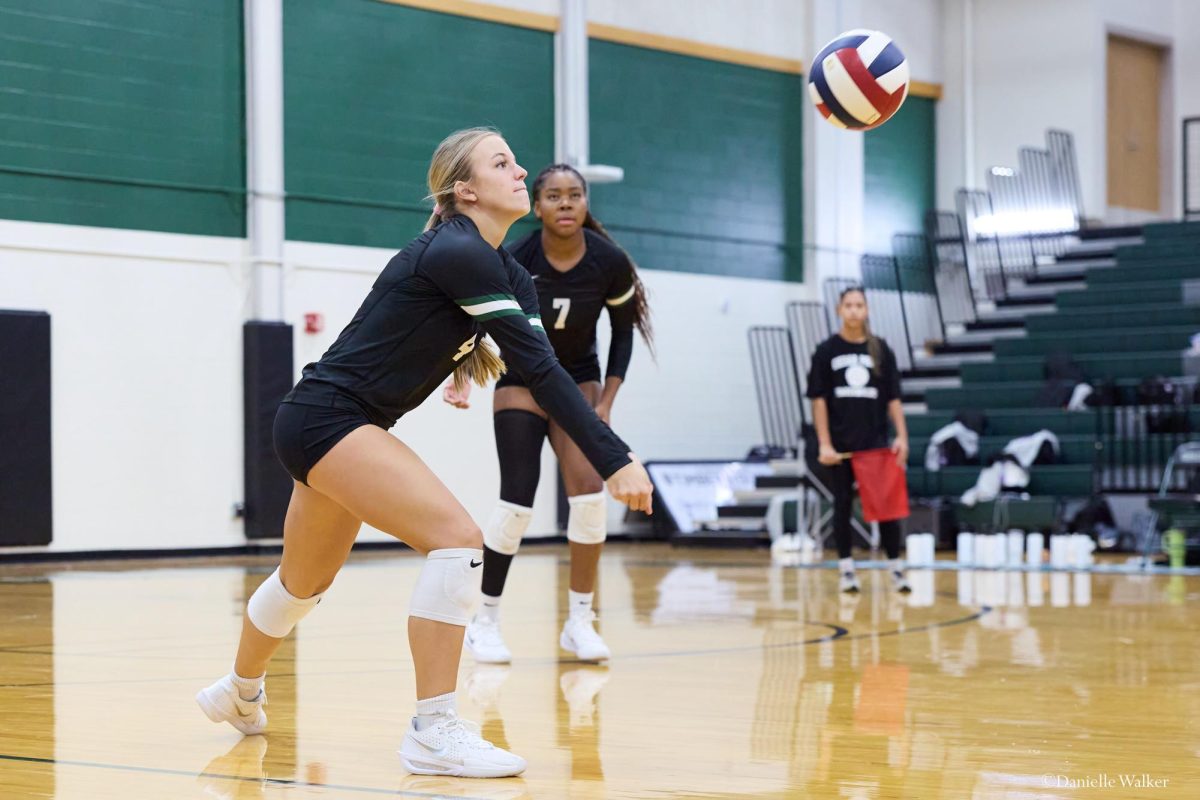Time seems to move slower once she straps the headgear on and walks onto the mat. She flips a switch in her mind, putting all her focus on her next move. Staring at her opponent, aggressiveness begins to build and in the next second her foot is at her opponent’s face. Two points. Her mood and rhythm have settled in and now she’s ready to win.
Junior Brooklyn Collinsworth, operations manager for the Wolfcast News, has recently developed a new hobby. While trying to get out of the on-campus P.E. credit sophomore year, Collinsworth decided to join Tiger-Rock Martial Arts and learn taekwondo. Since then, Collinsworth has found a passion in the art and hit her one year mark this August.
“I was not originally interested in martial arts,” Collinsworth said. “All of the options for [the P.E. credit] were either kickboxing or taekwondo or karate. I didn’t know the difference at the time, so I just chose the top one on the list and that was Tiger-Rock Martial Arts. [From there] it’s been my Batman origin story.”
Every martial arts company has their own belt rank system. For Tiger-Rock, there are 15 different belt levels. Starting out at white belts, students rank up to yellow, advance through three levels each of green, blue, brown, red and end at the highest rank of black belt. Collinsworth is currently a level two blue belt and plans to continue leveling up.
“There are six [belt-ranking] tests a year; one every couple months,” Collinsworth said. “[To improve in taekwondo] you have to show up every day and display the fact that you can do everything they teach you. Most people won’t show up for [testings] because they have other commitments and stuff; I don’t have a life so I’ve showed up to all of them. That’s how I’ve progressed so far. I have friends that should be red belts in theory, but they’re still blue belts because they haven’t tested or because they’ve failed testing.”
Taekwondo sparring consists of all types of strikes, including punches and kicking in the head. After one competitor gets a clean hit on their opponent, the two reset, and the referee reviews the point. The match consists of three rounds that are two minutes each. Collinsworth’s strategy to winning is her aggressiveness.
“I’m always aggressive [when I compete] and people don’t like that about me because I don’t really ‘chill out,’ or go into a defensive mode,” Collinsworth said. “I’m always attacking the other person. Because I’m constantly moving, I don’t have to worry about where they’re kicking [or] blocking. If I’m constantly moving at them, comboing different stuff, it’s very hard for them to block me and then I’m the one who gets the first point.”
Collinsworth became a certified instructor in January. To become an instructor, you must be at least 16 years old and pass a test. Collinsworth passed the test, which consisted of small details about taekwondo, with a perfect score. After passing her test, the other instructors handed her a black jacket which marked her new position as an instructor.
“[Tiger-Rock] asked me to become an instructor,” Collinsworth said. “I didn’t ask to be certified, I just love helping out and [my instructors] needed me to take over a little bit. I [started] helping out with classes because I enjoy teaching others something that makes me happy.”
Instructing five to thirteen year olds martial arts felt like church, Collinsworth said. Not getting paid, but having fun and dedicating five hours a day to instructing made her happy. Tiger-Rock has offered a job to her after she graduates high school, but she isn’t sure if that’s the route for her yet.
“[It’s] a big age group to work with and teaching them and seeing the realization on their face when they kick and say ‘oh, that’s how it’s supposed to be,’ that gives me a lot of joy,” Collinsworth said. “I’ve seen changes in kids in 3 months and that’s the coolest thing to see. To see them walk in and be kind of shy and not talk to anybody and then [after some time] they’re open and they’re honest and they’re fully themselves. That change makes me super happy.”
Third degree black belt and instructor Grace Hudgens has helped Collinsworth with her taekwondo journey. Hudgens has been doing martial arts since she was 16 and has always had teaching as an option in her career path since she comes from a long line of teachers. Wanting to become an elementary school teacher, she decided that taekwondo would give her experience with kids, as well as some that had disabilities or mental problems.
“The best part [of my job] for me is the kids,” Hudgens said. “I love teaching and seeing their eyes light up. [Martial arts] really helps with different types of behavioral issues. If someone has anger issues, if someone lashes out in class, at school, or if somebody just has a hard time focusing, martial arts is a great outlet for them. They can hit and smash any equipment. We never teach them to do that to students themselves, only for self defense if they’re in a real life [dangerous] situation. It’s a great [way] for them to get all that aggression and energy out while still having fun and learning how to defend themselves.”
So far, Collinsworth has been to two district competitions and competed in the Tiger-Rock Martial Arts National Championships Season 40 2023. Tiger-Rock only competes against other Tiger-Rock schools in Central Texas for their district competitions. For one district competition, she placed in all three events, and for the other competition, she placed in two events. For the most part, she earned gold. Since she won her districts, she was able to earn a spot in Nationals, with the title of an Allstar
“Nationals [was] much harder [than districts],” Collinsworth said. “I was the youngest person there. I competed against adult women that were in their thirties and that have been doing other martial arts on top of [taekwondo]. That was very intimidating and it was extremely difficult because they saw all my weak spots immediately. When you’re sparring, people continuously are learning as they’re watching you for your weak spots. If I’m using one kick, they’ll learn how to block that one kick. If I use the same kind of spin kick and I overturn my shoulder, they’re going to know that I’m going to do a spin kick because I’m turning my shoulder. They pay attention to stuff that I don’t really pay attention to. [That] helped me learn because I need to start doing that too if I’m able to get ahead.”
While at the championship, Collinsworth would face bigger and taller opponents. Being used to sparring against male opponents who were shorter than her at the studio made her height advantage nonexistent.
“[My opponents] were 6ft tall,” Collinsworth said. “I didn’t know the girls could be bigger than me. Height and weight makes a huge difference, even if you have skill. If you keep sparring your same body weight then you’ll learn everything they do and you don’t have a diverse area of [opponents] to practice [with]. You [need to] learn how to kick lower, kick higher.”
When matching up against opponents who are defensive, Collinsworth uses her angles. Constantly moving and circling each other, her best option is usually to corner them.
“My friend Reeve, who is also a blue belt, is extremely defensive so it’s very frustrating to spar him because he’s blocking everything I do and not kicking me,” Collinsworth said. “If I can go to the side, if I can corner him somehow, or if I can keep doing moves at him to the point where he can’t back up; that’s what you want to do.”
Besides sparring, the tournaments also hold board-breaking competitions. Martial artists will strike one or more boards, using special forms and if the board breaks, one point is awarded. At the board-breaking event during Nationals, Collinsworth was able to place third out of 16 competitors.
“[The tournament] used new boards for the board breaking, so when I hit them, they went down and straight back up,” Collinsworth said. “So it basically didn’t break, which [was] weird. I did end up getting bronze in the overall board breaking competition. My opponents were much older and had a lot more experience.”
Alongside taekwondo, Collinsworth has a white belt in Brazilian jiu-jitsu, and plans to improve more in that skill once she gets to college. Collinsworth has shown up for a couple of classes, but wants to keep her focus on taekwondo right now.
“When I get to college I think that I’m going to do Brazilian jiu-jitsu for real and not just show up for three classes and then not show up again,” Collinsworth said. “I haven’t been consistent enough to call myself a white belt, and the rules are a little bit different. I’ve been going to taekwondo five days a week since last year. I have not stopped going five days a week even during the school year or during the summer.”
Being able to go to the studio five times a week and learn new techniques and forms helped Collinsworth mentally.
“I was not happy with myself before I joined,” Collinsworth said. “Taekwondo is something that I can put my stress [into]. I had to watch myself a little bit [in the beginning] because [my instructors] were like ‘you hit too hard, stop it.’ That’s what lets all my stress out either from Broadcast or from what’s happening at home or homework or AP classes.”
While competing at Nationals, Collinsworth injured her opponent while sparring. During nationals, if your opponent is injured to the point where they have to get wheeled out, the one who injured them is disqualified.
“That was the one that I really wanted to do well in because I suck at forms,” Collinsworth said. “[Disqualifying] took a lot of my ego away. ‘Oh I’m so good, look at all my district [wins];’ it puts it in perspective that I do need to work a lot harder towards sparring especially and learning how to watch other people. Even though I don’t like point sparring, it’s playing the game. It’s figuring out how to get past your opponent, how to get the point. I still need to improve for [the] next nationals. I expect to kick butt next nationals.”
Because of the long hours she spends at the studio each week, Collinsworth is able to know everyone there very well. Whether it be practicing on her own skills or teaching younger students, the people involved quickly become close friends.
“It kind of builds a family and I know that’s super cliche, but you have to have a family if you’re kicking somebody in the head; there can’t be any beef between you,” Collinsworth said. “There can’t be any animosity, there has to be a family connection of like, ‘oh sorry man, sorry about that, that wasn’t intentional.’ I’ve become best friends with everybody in that studio very easily. My instructors are like my second parents. They look out for me the same way. You [have to] become close or else you can’t learn martial arts. It’s a very family-like setting. I know them so well and we’re having fun, we’re learning self defense and we’re sparring which are all things I love to do, like I take all my mask off because I’m allowed to be myself around them.”






![Senior Jett Mckinney stores all the clothes in his own room, with half of it stored in his closet along with his personal clothes, and the rest taking up space in his room.
“There’s been times [when] there’s so much clothing stored here and it gets overwhelming, so I end up having to sleep somewhere else in the house,” Mckinney said.](https://cphswolfpack.com/wp-content/uploads/2025/11/DSC_0951-1200x800.jpg)



![Broadcast, yearbook and newspaper combined for 66 Interscholastic League Press Conference awards this year. Yearbook won 43, newspaper won 14 and broadcast took home nine. “I think [the ILPC awards] are a great way to give the kids some acknowledgement for all of their hard work,” newspaper and yearbook adviser Paige Hert said. “They typically spend the year covering everyone else’s big moments, so it’s really cool for them to be celebrated so many times and in so many different ways.”](https://cphswolfpack.com/wp-content/uploads/2025/05/edited-ILPC.jpg)




![Looking down at his racket, junior Hasun Nguyen hits the green tennis ball. Hasun has played tennis since he was 9 years old, and he is on the varsity team. "I feel like it’s not really appreciated in America as much, but [tennis] is a really competitive and mentally challenging sport,” Nguyen said. “I’m really level-headed and can keep my cool during a match, and that helps me play a bit better under pressure.” Photo by Kyra Cox](https://cphswolfpack.com/wp-content/uploads/2025/09/hasun.jpg)

![Bringing her arm over her head and taking a quick breath, junior Lauren Lucas swims the final laps of the 500 freestyle at the regionals swimming competition on date. Lucas broke the school’s 18-year-old record for the 500 freestyle at regionals and again at state with a time of 4:58.63. “I’d had my eye on that 500 record since my freshman year, so I was really excited to see if I could get it at regionals or districts,” Lucas said. “ State is always a really fun experience and medaling for the first time was really great. It was a very very tight race, [so] I was a bit surprised [that I medaled]. [There were] a lot of fast girls at the meet in general, [and] it was like a dogfight back and forth, back and forth.” Photo by Kaydence Wilkinson](https://cphswolfpack.com/wp-content/uploads/2025/03/Kaydence-2.7-23-edit-2.jpg)


![As her hair blows in the wind, senior Brianna Grandow runs the varsity girls 5K at the cross country district meet last Thursday. Grandow finished fourth in the event and led the varsity girls to regionals with a third place placement as a team. “I’m very excited [to go to regionals],” Grandow said. “I’m excited to race in Corpus Christi, and we get to go to the beach, so that’s really awesome.” Photo by Addison Bruce](https://cphswolfpack.com/wp-content/uploads/2025/10/brianna.jpg)
















![Striking a pose in front of the Tiger-Rock Martial Arts National Championship banner, junior Brooklyn Collinsworth shows off her flexibility and blue belt. The tournament was held at the Henry B. González Convention Center in San Antonio from July 20-23. “I end[ed] up getting bronze in the overall board breaking competition,” Collinsworth said. “My opponents were much older and had a lot more experience.”](https://cphswolfpack.com/wp-content/uploads/2023/09/kickin.jpg)

Alyssa Fox • Sep 7, 2023 at 1:31 pm
SLAY HEIDI
Brooklyn Collinsworth • Sep 6, 2023 at 2:15 pm
Love this, thanks for the feature!
Kacey Miller • Sep 6, 2023 at 1:39 pm
LETS GO FIRST ARTICLE OF THE YEAR HEIDI